When Will Virtual-Reality Headsets Stop Making People Sick?

From the Oculus Rift headsets to the new HTC Vive, virtual-reality devices will soon be flooding the gaming market. These gadgets have the power to transport their wearers to another world, but the technology has also been plagued by some unwelcome side effects.
Companies have long known that virtual-reality headsets, 3D movies and related types of technology can cause "cybersickness," which has symptoms similar to motion sickness. The effects vary from person to person, and typically depend on the type of game and length of gameplay.
With virtual reality (VR) poised to revolutionize the gaming industry, the success of the technology may depend on how well companies can overcome these health issues. [9 Odd Ways Your Tech Devices May Injure You]
Scientists still don't really know how virtual reality affects the brain. In the real world, a person processes input from multiple senses that are all in perfect agreement, said Mayank Mehta, a neuroscientist at UCLA who studies how VR affects the brains of rats. But in virtual reality, "the brain is expecting everything to be in sync, but things are not in sync," Mehta told Live Science in February.
Perhaps the best-known virtual-reality product on the horizon is the Oculus Rift headset, made by Facebook-owned Oculus VR, a company based in Irvine, California. The headset is set to be released in November.
But the company has acknowledged that nausea problems continue to plague its device.
"People like the demo, they take it home and they start throwing up," John Carmack, chief technology officer of Oculus, said in a speech last week ata game developers conference in San Francisco, The New York Times reported.
Sign up for the Live Science daily newsletter now
Get the world’s most fascinating discoveries delivered straight to your inbox.
But these types of problems also affect users of other VR devices.
When Samsung released its Gear VR headset (powered by Oculus Rift software) for the Galaxy Note 4 smartphone in December, the product came with a lengthy health disclaimer. The company urged people to stop using the device if they experienced seizures, loss of awareness, eyestrain or nausea, among other symptoms. The disclaimer also stated that "prolonged use should be avoided" and that children under age 13 shouldn't use the device at all.
Live Science reached out to Samsung, but the company declined to comment.
Still, the industry may be showing signs of improvement. Taiwan-based mobile company HTC recently announced that it plans to release its own virtual-reality headset, the Vive, sometime this year. Unlike existing headsets that make people feel sick, the Vive's screen is designed to refresh 90 times a second, which should prevent users from getting nauseous, Jeff Gattis, HTC's executive director of marketing, said at HTC's Mobile World Congress press event, Tom's Guide reported. For comparison, the Oculus Rift refreshes at a maximum of 75 times per second.
HTC declined to comment on any VR-related health issues until it gets closer to the Vive's release date.
Sony is getting in on the virtual-reality market too, with an initiative code-named Project Morpheus. The company is designing a VR headset for the PlayStation 4 and PlayStation Vita game consoles that's slated for release in the first half of 2016.
Follow Tanya Lewis on Twitter. Follow us @livescience, Facebook & Google+. Original article on Live Science.











